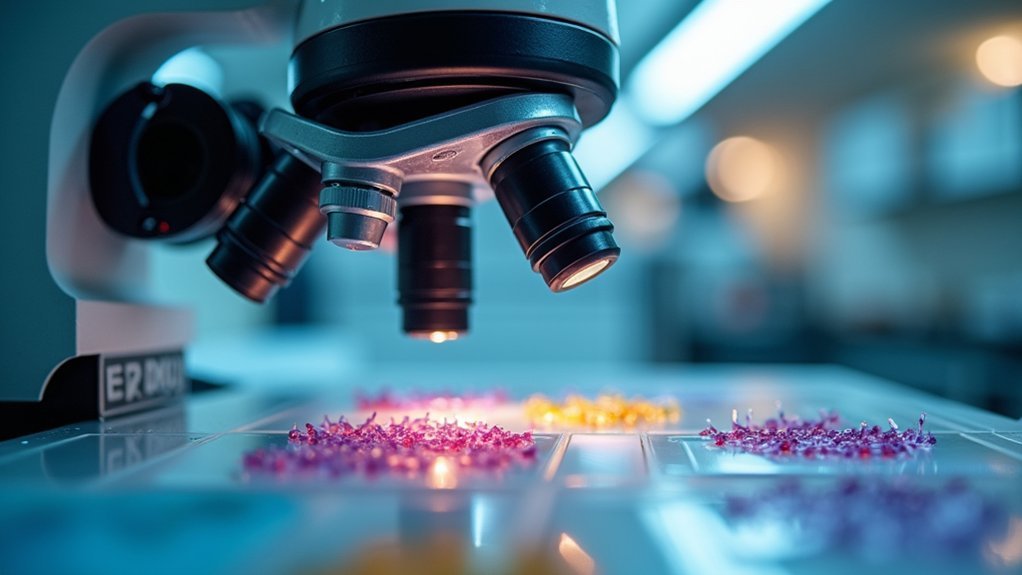The three best camera sensors for scientific imaging are back-illuminated sCMOS sensors (offering 95% quantum efficiency for low-light conditions), EMCCD cameras (providing 30-100 fps with signal amplification for dynamic processes), and scientific CMOS sensors (enabling high-throughput imaging with parallel processing). You’ll want to match sensor technology to your specific needs, balancing resolution, sensitivity, and speed. Understanding these sensor differences helps you make the best choices for your research applications.
Microscope Sensor Size Impact on Field of View and Resolution

When selecting a camera for scientific imaging, the sensor size plays an essential role in determining both your field of view and resolution capabilities.
Larger camera sensors provide wider FOV, allowing you to capture more of your specimen in a single frame—crucial when examining extensive tissue samples or cell cultures.
Smaller formats like 1/2.3-inch sensors deliver narrower fields of view but may be suitable for targeted observations. However, sensor size directly affects resolution quality; larger sensors accommodate more pixels, producing sharper, more detailed images essential for precise analysis.
For enhanced performance in challenging conditions, consider scientific CMOS cameras with back-illuminated sensors. These improve light sensitivity even in smaller formats, offering superior resolution in low-light environments without sacrificing field coverage.
Calculating Optimal Pixel Density for Scientific Microscopy Imaging
Although many researchers focus primarily on resolution and sensitivity, determining the ideal pixel density is equally vital for achieving accurate scientific imaging results.
To enhance image quality in microscopy, you’ll need to apply the Nyquist criterion, which recommends your pixel size be at least half the smallest detail you want to resolve.
Applying the Nyquist criterion ensures every microscopic detail is properly captured—use pixel sizes half the dimension of your smallest target feature.
For scientific microscopy, consider these important factors:
- High-resolution imaging typically requires 1.0-1.5 micron pixel density to capture fine details without aliasing artifacts
- Your field of view directly impacts the total pixel count needed to maintain detail quality
- Advanced sensors like sCMOS and back-illuminated CMOS offer up to 61 megapixels for complex sample imaging
- Ideal pixel density requires balancing frame rate and sensitivity, as higher densities may reduce performance in low-light conditions
Matching Camera Sensor Technologies to Microscopy Applications

Selecting the right sensor technology for your microscopy application can dramatically impact image quality and experimental outcomes.
When evaluating options for a variety of applications, consider how every single imaging parameter affects your results.
For low-light conditions, back-illuminated sCMOS sensors with up to 95% quantum efficiency, like the Prime 95B, deliver exceptional sensitivity.
If you’re capturing fast dynamic processes, EMCCD cameras operating at 30-100 fps provide the necessary speed with signal amplification.
Traditional CCDs offer high resolution but struggle with moving samples.
For high-throughput imaging, scientific CMOS sensors enable parallel processing and faster acquisition times.
The ideal choice balances resolution, sensitivity, and speed based on your specific needs.
sCMOS technology has emerged as a versatile solution for life sciences, combining these critical performance factors.
Frequently Asked Questions
What Is the Best Camera for Image Detection?
For image detection, you’ll find that back-illuminated sCMOS cameras like the Prime 95B are your best option. They offer 95% quantum efficiency and excel in low-light conditions where detail matters most.
Are CCD Sensors Better?
CCD sensors aren’t necessarily better. They offer high resolution and good light sensitivity but have limitations in speed, field of view, and full-well capacity compared to newer technologies like EMCCDs and sCMOS.
What Is the Highest Resolution Camera Sensor?
The highest resolution camera sensor currently available is the Aluma AC455 from SBIG with 61 megapixels. You’ll find it’s designed specifically for detailed imaging where capturing fine elements is essential.
What Cameras Do Scientists Use?
Scientists typically use CCD, EMCCD, and CMOS-based cameras. You’ll find they choose these based on your research needs, preferring specialized options like SBIG Aluma series or back-illuminated sCMOS cameras for their sensitivity and speed.
In Summary
When you’re selecting camera sensors for scientific imaging, you’ll need to contemplate the relationship between sensor size and field of view, calculate the ideal pixel density for your specific microscopy needs, and carefully match sensor technology to your application. By understanding these three critical factors, you’ll capture higher quality images with better resolution and achieve more accurate research results in your scientific imaging workflow.





Leave a Reply